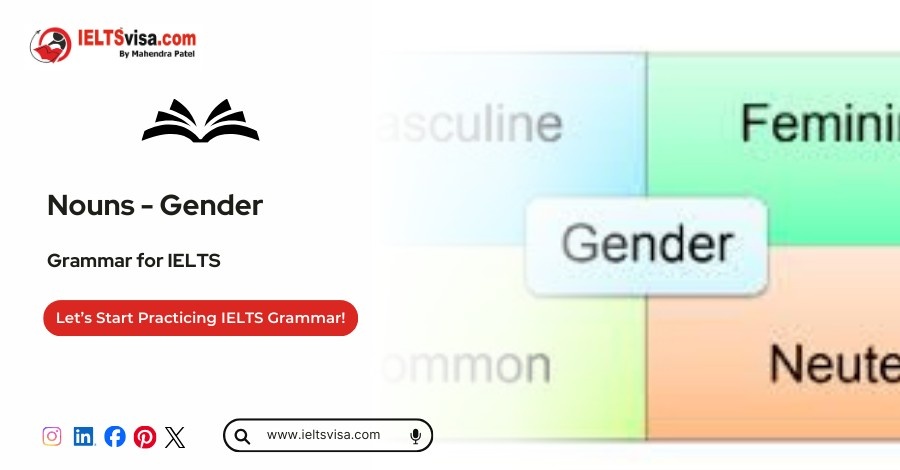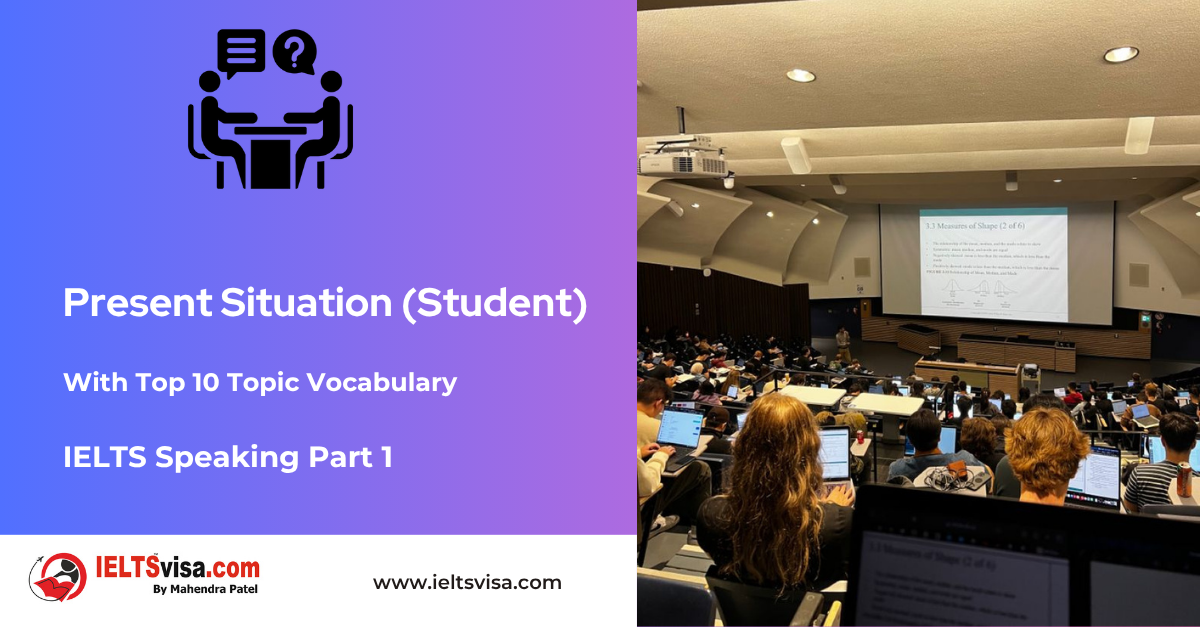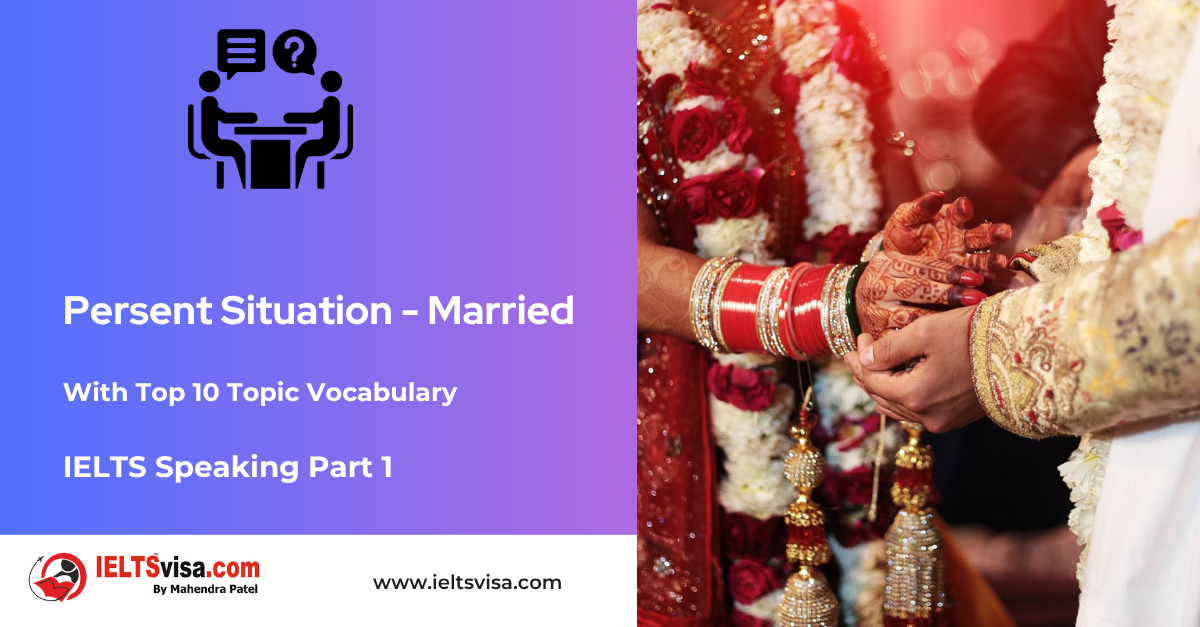Nouns and Gender
Grammar for IELTS

Nouns and Gender: Definition, Types, and Examples
In English grammar, nouns and pronouns are often associated with gender classifications. While many nouns are gender-neutral (neuter gender), those related to people and animals can have specific masculine or feminine forms. This article examines the meaning, definition, and examples of gender in English grammar, aiming to provide a clear understanding of this concept.
Table of Contents
1. What Is Gender in Grammar? – Meaning and Definition
2. Types of Gender with Examples
-
- Masculine Gender
- Feminine Gender
- Neuter Gender
- Common Gender
3. Examples of Gender in English Grammar
4. Frequently Asked Questions on Gender in English Grammar
What Is Gender in Grammar? – Meaning and Definition
Gender in grammar refers to the classification of nouns and pronouns as masculine, feminine, neuter, or common. Gender helps determine how other words in a sentence interact with the noun or pronoun in terms of agreement and grammatical forms.
Definition:
-
- According to the Oxford Learner’s Dictionary, gender is defined as “each of the classes (masculine, feminine, and sometimes neuter) into which nouns, pronouns, and adjectives are divided; the division of nouns, pronouns, and adjectives into these different genders. Different genders may have different endings, etc.”
- The Merriam-Webster Dictionary describes gender as “a subclass within a grammatical class (such as noun, pronoun, adjective, or verb) of a language that is partly arbitrary but also partly based on distinguishable characteristics and that determines agreement with and selection of other words or grammatical forms.”
Types of Gender with Examples
Nouns and pronouns in English can be categorized into four primary genders: masculine, feminine, neuter, and common. Let’s explore each type with definitions and examples.
Masculine Gender
Definition: Refers to nouns and pronouns used to denote male persons or animals.
Examples:
-
- Man
- Boy
- Father
- King
- Stallion
- Lion
In Sentences:
-
- The king addressed his people.
- A lion is known for its strength.
Feminine Gender
Definition: Refers to nouns and pronouns used to denote female persons or animals.
Examples:
-
- Woman
- Girl
- Mother
- Queen
- Mare
- Hen
In Sentences:
-
- The queen ruled wisely.
- A mare is grazing in the field.
Neuter Gender
Definition: Refers to nouns that are neither male nor female. These nouns are inanimate objects or concepts that have no gender.
Examples:
-
- Book
- Car
- River
- Mountain
- Chair
In Sentences:
-
- The book is on the table.
- The river flows through the valley.
Common Gender
Definition: Refers to nouns that can denote either male or female.
Examples:
-
- Teacher
- Doctor
- Student
- Friend
- Parent
In Sentences:
-
- The teacher explained the topic clearly.
- A doctor should always care for their patients.
Examples of Gender in English Grammar
Here are additional examples of gender classifications:
|
Masculine Gender |
Feminine Gender |
Neuter Gender |
Common Gender |
|
Man |
Woman |
Book |
Teacher |
|
Boy |
Girl |
Chair |
Doctor |
|
King |
Queen |
Car |
Student |
|
Uncle |
Aunt |
River |
Parent |
|
Stallion |
Mare |
Mountain |
Friend |
Frequently Asked Questions on Gender in English Grammar
Q1. What is gender in English grammar?
Gender in grammar indicates whether a noun or pronoun is masculine, feminine, neuter, or common. While many nouns in English are gender-neutral, those related to people and animals often have gender-specific forms.
Q2. What is the definition of gender in grammar?
-
- The Oxford Learner’s Dictionary defines gender as “each of the classes (masculine, feminine, and sometimes neuter) into which nouns, pronouns, and adjectives are divided.”
- The Merriam-Webster Dictionary describes it as “a subclass within a grammatical class (such as noun, pronoun, adjective, or verb) of a language.”
Q3. What are the types of gender in English grammar?
The four types of gender in English grammar are:
- Masculine Gender
- Feminine Gender
- Neuter Gender
- Common Gender
Q4. Give some examples of masculine and feminine genders.
-
- Masculine: Man, Boy, King, Lion
- Feminine: Woman, Girl, Queen, Mare
Q5. Are there any gender-neutral nouns in English?
Yes, examples include books, cars, teachers, doctors, and rivers. These nouns are classified as neuter or common gender, depending on their usage.

Our Books
Master IELTS Speaking Part 1
IELTS Writing Task 1 Book
IELTS Writing Task 2 Book
Practice IELTS Other Modules
IELTS Listening
The IELTS Listening test assesses how well you can understand spoken English in various contexts. It lasts about 30 minutes and is divided into four sections with a total of 40 questions. The listening tasks become increasingly difficult as the test progresses.
IELTS Academic Reading
The IELTS Academic Reading section assesses your ability to understand and interpret a variety of texts in academic settings. It is designed to evaluate a range of reading skills, including skimming for gist, reading for main ideas, reading for detail, understanding inferences, and recognizing a writer's opinions and arguments.
IELTS Speaking
The IELTS Speaking test assesses your ability to communicate in English on everyday topics. It lasts 11-14 minutes and consists of three parts: introduction, cue card, and a discussion based on the cue card topic.
IELTS General Reading
IELTS General Reading tests your ability to understand and interpret various types of texts. Here are some key areas and types of content you can expect to encounter in the reading section, along with tips for effective preparation.
IELTS Academic Writing Task 1
In IELTS Academic Writing Task 1, you are presented with a visual representation of information, such as graphs, charts, tables, or diagrams, and you are required to summarize, compare, or explain the data in your own words.
IELTS General Writing Task 1
In IELTS General Writing Task 1, you are required to write a letter based on a given situation. The letter can be formal, semi-formal, or informal, depending on the prompt. Here’s a breakdown of the key components to include in your letter
IELTS Academic Writing Task 2
In IELTS Academic Writing Task 2, you are required to write an essay in response to a question or topic. Here’s a guide to help you understand the essential elements of this task
IELTS Exam Tips
To succeed in the IELTS exam, practice regularly, familiarize yourself with the test format, improve your vocabulary, develop time management skills, and take mock tests to build confidence.
Grammer for IELTS
Grammar is the foundation of effective communication in English. Understanding tense usage, subject-verb agreement, and sentence structure enhances clarity and coherence in writing and speaking.
Vocabulary for IELTS
Vocabulary plays a crucial role in the IELTS (International English Language Testing System) exam, especially in the Speaking and Writing sections. Here’s an overview of why vocabulary is important and how it impacts your performance
RECENT IELTS SAMPLES QUESTIONS AND ANSWERS
IELTS Speaking Part 1 – Favourite Sujbect – Physics
IELTS Speaking Part 1 - Favourite Sujbect - Physics Q: What is your favourite subject? A: My favourite subject...
IELTS Speaking Part 1 – Present Situation (Student)
IELTS Speaking Part 1 - Present Situation (Student) Q1: Are you a student or do you work?A: I’m a full-time...
IELTS Speaking Part 1 – Present Situation – Employee – as an International Student and Social Worker
IELTS Speaking Part 1 - Present Situation - Employee - as an International Student and Social Worker Q1: Are...
IELTS Speaking Part 1 – Persent Situation – Employee- as an Electric Engineer
IELTS Speaking Part 1 - Persent Situation - Employee- as an Electric Engineer Q1: What do you do for a...
IELTS Speaking Part 1 – Persent Situation – Employee – as an Software Engineer
IELTS Speaking Part 1 - Persent Situation - Employee - as an Software Engineer Q1: What do you do for a...
IELTS Speaking Part 1 – Persent Situation – Married
IELTS Speaking Part 1 - Persent Situation - Married Q1: Are you married?A: Yes, I am married. My spouse and I...












